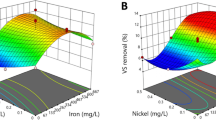Abstract
A whey solution was used as a substrate for methane production in an anaerobic fixed-bed reactor. At a hydraulic retention time of 10 days, equivalent to a space loading of 3.3 kg (m3 day)−1, 90% of the chemical oxygen demand was converted to biogas. Only a little propionate remained in the effluent. Toxicity tests with either copper chloride, zinc chloride or nickel chloride were performed on effluent from the reactor. Fifty per cent inhibition of methanogenesis was observed in the presence of ≥10 mg CuCl2 l−1≥40 mg ZnCl2 l−1 and ≥60 mg NiCl2 l−1, respectively. After exposure to Cu2+, Zn2+ or Ni2+ ions for 12 days, complete recovery of methanogenesis by equimolar sulfide addition was possible upon prolonged incubation. Recovery failed, however, for copper chloride concentrations ≥40 mg l−1. If the sulfide was added simultaneously with the three heavy metal salts, methanogenesis was only slightly retarded and the same amount of methane as in non-inhibited controls was reached either 1 day (40 mg ZnCl2 l−1) or 2 days later (10 mg CuCl2 l−1). Up to 60 mg NiCl2 l−1 had no effect if sulfide was present. Sulfide presumably precipitated the heavy metals as metal sulfides and by this means prevented heavy metal toxicity.
Similar content being viewed by others
Author information
Authors and Affiliations
Additional information
Received: 8 October 1999 / Received revision: 3 January 2000 / Accepted: 4 January 2000
Rights and permissions
About this article
Cite this article
Zayed, G., Winter, J. Inhibition of methane production from whey by heavy metals – protective effect of sulfide. Appl Microbiol Biotechnol 53, 726–731 (2000). https://doi.org/10.1007/s002530000336
Issue Date:
DOI: https://doi.org/10.1007/s002530000336




